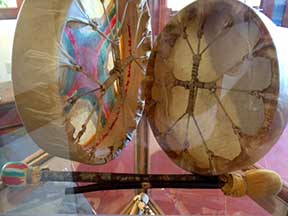By Sarah Reith For The Ukiah Daily Journal
The Franklin family home is a museum full of beadwork, dance regalia, paintings, and drawings by all members of the family.
 The Franklin family home is a museum. Beadwork, dance regalia, paintings, and drawings by all the members are on display everywhere. Patricia Ray Franklin and her children, Tim (11), Joshua (9), and Sarah (6), are members of the Scotts Valley Band of Pomo, and they have been making their own dance regalia for three years. “We didn’t even consider it art,” said Franklin. “We were just thinking of it as regalia.” But then Kirsten Gantzell, a teacher who works with the family’s children, suggested they get in touch with the Arts Council. Their art show will open on Friday, November 6 at the Ukiah Depot, on 309 Perkins Street in Ukiah.
The Franklin family home is a museum. Beadwork, dance regalia, paintings, and drawings by all the members are on display everywhere. Patricia Ray Franklin and her children, Tim (11), Joshua (9), and Sarah (6), are members of the Scotts Valley Band of Pomo, and they have been making their own dance regalia for three years. “We didn’t even consider it art,” said Franklin. “We were just thinking of it as regalia.” But then Kirsten Gantzell, a teacher who works with the family’s children, suggested they get in touch with the Arts Council. Their art show will open on Friday, November 6 at the Ukiah Depot, on 309 Perkins Street in Ukiah.
“I learned the Mendocino County way” of practicing Pomo culture, Franklin said, “but the Lake County way was all new to me.” The biggest difference between the Eastern Pomo and the Northern and Central Pomo cultural practices, she noted, “is the songs,” because the languages are different. Franklin credits Meyo Marrufo, an indigenous cultures advocate, with helping her family learn about practices that were nearly lost.
The reason Franklin is discovering so much about her culture as an adult has to do with the termination era, which began in 1953 with House Concurrent Resolution 108. This was a resolution to terminate federal responsibilities towards tribes in an effort to bring about rapid cultural assimilation. It led to several termination statutes, including the Rancheria Act of 1958, which ended federal responsibilities to 41 Rancherias in California. “We terminated and re-located to Oakland and all that,” Tim explained. It wasn’t until the early 1990s that many communities regained their tribal status, and, in many cases, lands that had been annexed during the termination era. “We had to be re-recognized,” Tim concluded. “It’s been such a long process,” his mother concurred, “but I tell my kids, they’re a part of history, bringing the culture back.”
A large part of any culture is how its people dance. The Scotts Valley Band of Pomo is slightly different from other local tribes, in that their Big Time is only once a year, rather than once a season. Most dances are a combination of celebration and prayer. “While you’re dancing,” Franklin said, “other natives come up and say, my mom’s sick, or something. When you’re dancing, you’re praying, inviting the Creator to come and help and bless.”
Not everything is strictly traditional, though. Tim tied a flicker band around his forehead, simultaneously shading his eyes and displaying his family’s craftsmanship. His mother confessed that mostly, the feathers were duck quills, adding that “I don’t know if I would ever be able to kill a flicker.” In addition to improvising on some of the regalia, horseshoes were featured at the last Big Time, a gathering where traditional games and ceremonies are practiced.
“Stick games are the funnest to watch, for me,” Tim said of the last Big Time. “It’s the kind of game you can get good at.” This is a combination of guessing and skill, where one person has to guess in which hand another person is hiding a particular kind of stick.
Several sticks are used in the dances and ceremonies. The Franklins displayed some clapper sticks they have made, one of traditional elderberry and one of bamboo. Mrs. Franklin demonstrated how to keep time with it, and explained that clapper sticks can be used as guide sticks, too. The guide stick, she explained, “represents leading through life.” Dancers use it during ceremonies, and are expected to keep it all their lives, to be reminded of the proper direction to follow.
The Franklin family started moving in an artistic direction when Joshua was 2 years old and had to spend months at a time in the hospital with leukemia. “He always had a pencil, pen, Legos, anything,” Franklin said. She started doing beadwork while she was waiting for her son to recover, and soon, the entire family was painting and drawing, in addition to working with leather and beads.
Joshua’s current artwork leans towards the abstract, with symmetrical shapes and bold color choices. “It’s a person with headphones,” he told a reporter, as a mass of black brushstrokes resolved itself into the beard of a man listening to music.
Sarah’s work is whimsical. Asked about a drawing that resembled a fish swimming underneath some flowers, she finally replied that “it’s a dream in a hat.”
The Franklin family’s artwork and regalia will be on display at 309 Perkins Street, in Ukiah, for the month of November and December.